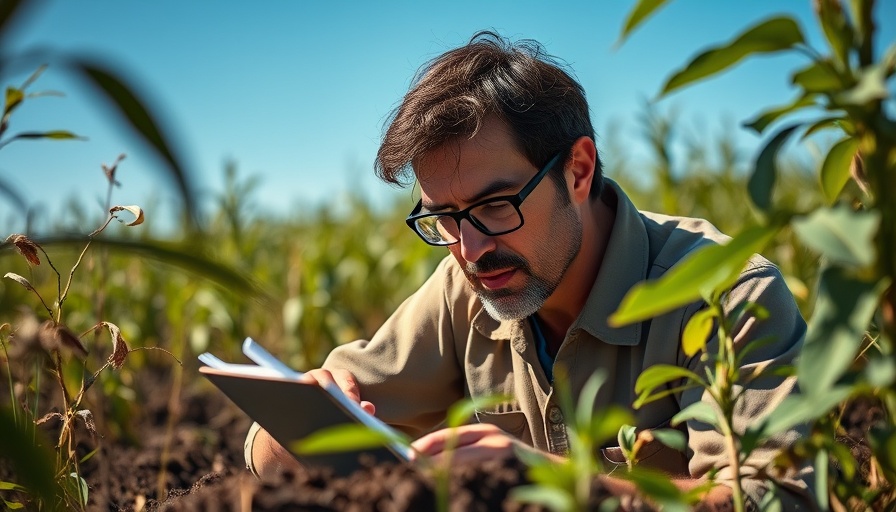
Unveiling the Secrets to Healthy Soil in Your Garden
Healthy plants might grab all the attention, but the health of your soil is the foundation on which everything grows. Just as gardeners meticulously tend to their leaves and flowers, understanding the underlying causes of soil issues can drastically improve the outcome of your gardening efforts. Whether your garden is struggling with constant issues or you’re aiming for a vibrant paradise, diagnosing soil problems beforehand can save you time, money, and most importantly, frustration.
Understanding the Triggers: Watering Wisely
Many gardeners overlook the importance of proper watering techniques. Overwatering can quickly ruin good soil, leaching nutrients and leading to problematic root systems. As water displaces oxygen in the soil, it can create an environment where fungal diseases thrive, and healthy plants begin to suffer. Signs to watch out for include constantly soggy ground, yellowing leaves, and visible algae growth on the soil's surface. An easy way to monitor moisture levels is by inserting your finger into the soil up to your second knuckle. If it feels dry at that depth, it’s time to water.
The Silent Squeeze: Effects of Soil Compaction
Compacted soil can stifle plant growth by reducing pore space necessary for air and water to flow. Heavy foot traffic, machinery, and even your pet can compress soil, making it feel hard and unyielding. Signs of compaction include water pooling on the surface and shallow root systems. To combat this issue, consider annual aeration, especially in areas with significant foot traffic. Easy solutions like stepping stones can prevent excessive pressure on garden beds while adding organic matter can enhance soil structure, allowing roots to penetrate more deeply. Discovering ways to loosen your soil can make a substantial difference over time.
Nutrient Levels: Less Can Be More
One of the most common misconceptions is that more fertilizer equals healthier plants. In reality, excessive applications can bridge the gap to plant damage, with signs such as burnt leaf tips indicating nutrient overload. To ensure you’re providing just the right amount of nutrients, conduct soil tests to ascertain the needs of your garden. Basic testing kits are available online and can reveal essential nutrient levels, helping you tailor your fertilization approach effectively.
The Complexity of Soil Fertility and Nutrient Balance
It’s not always easy to identify when plants are struggling from nutrient deficiencies as they can present subtle symptoms. For instance, yellowing leaf veins might indicate a lack of magnesium or iron while a purplish hue on leaves suggests phosphorus deficiency. A practical approach to improving fertility includes the utilization of crop rotations and organic compost. Commercial fertilizers often exhibit inefficiencies in nutrient absorption, and integrating sustainable methods will cater to overall soil health.
Great Soil Starts with Good Tilth
Tilth refers to the state of soil with respect to its suitability for planting and the ease with which it can be worked. Soils with good tilth provide optimal conditions for root growth, drainage, and nutrient absorption. Enhancing the tilth of your garden soil means adding organic matter, like compost, to improve soil structure, and aeration. A well-aerated soil allows water and nutrients to permeate deeper, fostering a thriving ecosystem for plants.
Future Trends in Sustainable Gardening
Looking ahead, sustainable gardening practices are increasingly recognized as paramount. These practices not only promote a healthy garden but also contribute to a more balanced ecosystem. Implementing cover crops, utilizing rainwater harvesting, and integrating permaculture concepts can further enhance soil health and mitigate issues before they arise.
The Takeaway: Act Now for a Flourishing Garden
To maintain a healthy garden, stay proactive about your soil's health! Understanding the fundamental aspects of soil maintenance can lead to more vibrant plants and bountiful harvests. Don't hesitate to explore modern technologies and sustainable practices that will seamlessly integrate smart strategies into your gardening routine.
As seasoned homeowners looking to optimize your outdoor spaces, the choices you make today will undoubtedly ripple through the future of your garden. So get out there, test your soil, experiment with natural amendments, and watch as your garden transforms into a lush sanctuary.
 Add Row
Add Row  Add
Add 




Write A Comment